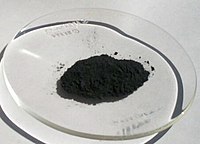
Photo from wikipedia
Diphenyldiazomethane and a labile chlorobenzene complex of [(η5-C5H5)Re(NO)(PPh3)]+ BF4- react to give the η1 adduct [(η5-C5H5)Re(NO)(PPh3)(NNCPh2)]+ BF4- (73%). When this is conducted in the presence of copper powder, a 3-phenyl-1H-indazole… Click to show full abstract
Diphenyldiazomethane and a labile chlorobenzene complex of [(η5-C5H5)Re(NO)(PPh3)]+ BF4- react to give the η1 adduct [(η5-C5H5)Re(NO)(PPh3)(NNCPh2)]+ BF4- (73%). When this is conducted in the presence of copper powder, a 3-phenyl-1H-indazole complex derived from carbon-hydrogen bond activation, [(η5-C5H5)Re(NO)(PPh3)(NC(Ph)CCHCHCHCHCNH)]+ BF4-, is obtained (65%). Subsequent reaction with NaOCH3 gives indazolyl complex (η5-C5H5)Re(NO)(PPh3)(NCCHCHCHCHCC(Ph)N) (85%), derived from NH deprotonation and a 1,2-rhenium shift. Crystal structures of the three new complexes are determined. DFT calculations are used to probe the mechanism of the 1,2-shift and energetics of alternative Re-N rotamers and linkage isomers, and assign bond orders and dominant resonance formulations.
Journal Title: Dalton transactions
Year Published: 2022
Link to full text (if available)
Share on Social Media: Sign Up to like & get
recommendations!